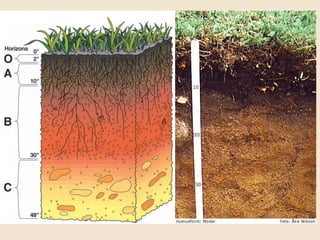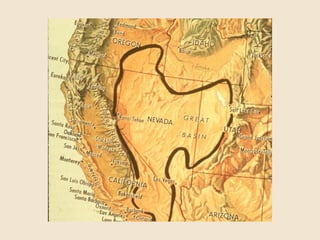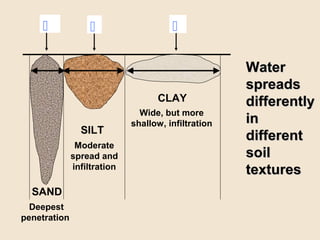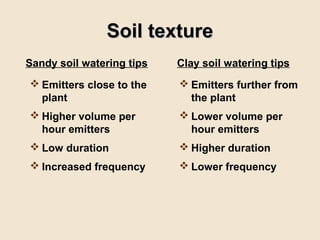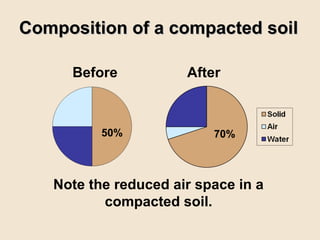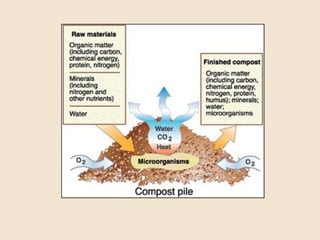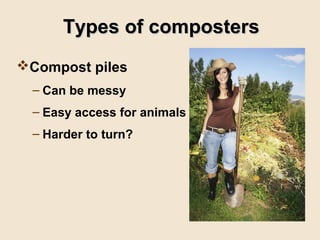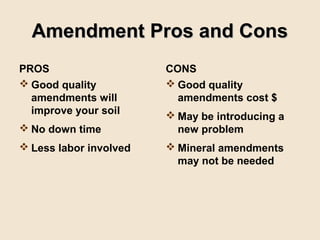Grow Your Own, Nevada! Fall 2011: Soil Amendments, Composting and Cover Crops
- 1. Improving Nevada’s Soils What is healthy soil? How does soil form? How can you improve your soil? – Compost – Amendments – Cover Crops – Mulches
- 2. Healthy soil has: Good porosity Good drainage Good water-holding capacity Good tilth, meaning they’re easy to work Lots of organic matter Lots of organisms A pH of about 7 OSU Extension Service Low salinity and sodium levels
- 3. Test Your Soil Low cost testing through UNCE – pH – EC – Soil Texture Soil Labs – contact UNCE for a list of labs
- 4. How are soils formed? A. Miller
- 7. Nevada Soils Many challenges – Climate – Organisms – Parent material – Time – Topography
- 11. comcast.net
- 12. scioly.org
- 13. ucanr.org
- 14. Compare horizons OSU Extension Service
- 15. It’s not your fault! Nevada soils are: – Young, geologically – Complicated by new inputs – Formed in the desert, so alkaline (high pH) – Formed in the desert, so low organic content
- 16. What are soils made of? Minerals Air Water www.statlab.iastate.edu Organic matter (humus) USDA NRCS
- 17. “Ideal” composition of a soil Mineral Water = 20 to 30% Fraction (sand, silt, clay) = 45 to 50% Air = 20 to 30% Organic Matter = 0 to 5%
- 18. Soil minerals textural classes A. Miller
- 19. The dreaded soil textural triangle! A. Miller
- 20. Textural triangle for the graphically challenged NRCS, Bozeman Mont.
- 21. Why determine soil texture? Soil texture influences: Water infiltration rates Water-holding capacity Ease of tillage Amount of pore space or porosity Soil fertility or nutrient-holding capacity
- 22. Soil texture and drainage A. Miller Infiltration rate, Soil texture inches per hour Sand 2-4 Sandy loam 1-3 Silt loam, loams 0.25 – 1.5 Silty clay loams, clay 0.1 – 0.3
- 23. Water spreads CLAY differently Wide, but more shallow, infiltration in SILT different Moderate spread and soil infiltration textures SAND Deepest penetration
- 24. Sand versus Clay Clay - “Heavy” soil - High water-holding capacity - Slow infiltration - High nutrient-holding capacity Sand - “Light” soil - Low water-holding capacity - Fast infiltration - Low nutrient-holding capacity
- 25. Where do plants get their water from in the root zone? Adapted from PNW 475 by A. Miller
- 26. Soil texture Sandy soil watering tips Clay soil watering tips Emitters close to the Emitters further from plant the plant Higher volume per Lower volume per hour emitters hour emitters Low duration Higher duration Increased frequency Lower frequency
- 27. Can you change soil texture? No, not really! Add sand to clay – mess! Add clay to sand – mess! Texture may limit your plant choices How can you improve your soil texture? Add organic matter!
- 28. Soil organic matter consists of: Living organisms Dead organisms Plant matter Other decomposing organic materials
- 29. Benefits of soil organic matter Improved water infiltration Increased water- and nutrient- holding capacity Formation of soil into stable aggregates Reduced soil compaction
- 31. Water molecule
- 32. Nutrients held in the soil are available for plant growth lesco.com
- 33. Soil structure: How particles are grouped together into stable collections by organic matter “glue,” also called “peds” or soil aggregates www.statlab.iastate.edu/soils/ Platy Granular structure structure
- 34. Soil Structure
- 35. Composition of a compacted soil Before After 50% 70% Note the reduced air space in a compacted soil.
- 36. Soil Compaction
- 37. Soil compaction
- 38. Avoid walking or driving on wet soil Avoid working wet soil OSU Extension Service
- 39. The wetter the soil, the worse the compaction effect by mechanized equipment on soil extension.umn.edu
- 40. Adding organic matter: Improves water infiltration Increases water- and nutrient-holding capacity Forms soil into stable aggregates Reduces soil compaction Also – feeds soil biota!
- 41. The living soil USDA NRCS
- 42. worm USDA NRCS
- 45. Add organic matter to your soil What kind of organic matter? Composted or well-rotted OM OSU Extension Service
- 46. OSU Extension Service What about manure? Uncomposted manure can be high in salts (burns plants and seeds) and can contain weed seeds, diseases, and insect eggs and larva.
- 47. UNCE Reno, Nev. Household vegetable debris, fall leaves and grass clippings can also be used to make compost
- 49. Types of composting Slow composting – Less labor intensive – Slower product production – Good for folks that produce low volumes Fast composting – More labor intensive – Quicker production – Good for folks that produce higher volumes
- 50. Types of composters Compost piles – Can be messy – Easy access for animals – Harder to turn?
- 51. Types of composters Compost tumblers Bin composters – Neater, cleaner
- 52. Steps to creating a compost pile Pick a site – Level, well-drained – Build on bare soil for bacteria – Shade – Near water and source of raw materials – Esthetically pleasing?
- 53. Steps to creating a compost pile Pile size – Cool or slow composting – Hot or active composting • At least a cubic yard (3’ x 3’ x 3’) • Not more than 5’ cube
- 54. Steps to creating a compost pile Ingredients – Ratio of 1:2 (1:1) green to brown material – Finer the size, quicker to compost – Too fine and it will compact 1-1.5” is best – Sprinkle some soil or finished compost every 8 to 12 inches as you build the pile
- 55. What to Compost Green Materials – Grass clippings – Animal manure (from herbivores only) – Non-animal-based kitchen wastes – Garden trimmings Dry or Woody (“Brown”) Materials – Fall leaves, dry cornstalks – Wood chips or sawdust (caution) – Hay or straw (soiled or clean)
- 56. What not to compost Yard trimmings or grass clippings treated with pesticides. They may kill the beneficial organisms in the compost pile or later in your garden. Weeds, if the pile will not be hot enough to kill the seeds. Diseased or insect-infested plant parts. The diseases or insects may be transferred to the soil with the compost. Parts of any plant known to contain poisons or toxins, such as black walnut. Too much of any plant that contains tannins or resins that inhibit decomposition, such as junipers, pine, spruce, arborvitae, oak or cottonwood. Meat or fish bones or scraps. Dairy products.
- 57. What not to compost Charcoal ash, as this may contain substances harmful to plants. Fireplace ashes, since they have a very high pH, as do our native soils. High pH levels can result in nutrient deficiencies and other plant problems. Fats, grease, lard or oils. These do not break down quickly and may attract pests, vermin, dogs or large carnivores. Pet wastes, such as dog or cat feces or soiled cat litter. They may contain parasites, bacteria or viruses harmful to humans. Swine or other omnivore wastes. They also may contain parasites, bacteria or viruses harmful to humans.
- 58. Steps to creating a compost pile A d d W a t e r
- 59. Steps to creating a compost pile Mix the pile – Weekly for hot or active composting – Whatever for slow or cool composting – Should reach 120 to 160 degrees – After 6-8 weeks of cooking, pile needs to cure for another 4-8 weeks – Turn pile while it is curing also
- 60. Preventing problems Nuisance insects and animals Food wastes can attract them May need to vermiculture or worm compost or compost tumble high volumes of food wastes
- 62. Composting Pros and Cons PROS CONS Recycle nutrients back Can be messy and/or into your soil smelly Reduces waste to your Can be labor intensive garbage can and landfill Can attract vermin, It is a cost-effective predators, stray dogs, etc. method of improving Can be weather dependent your soil Do you have space? Get good at producing it, you will have many Do you have time to friends wanting some manage?
- 63. What if I don’t want to compost? How about buying soil amendments? – Steer manure – Compost – Worm castings – “Triple mix” – Neighbor’s horse manure – Fireplace ashes – Gypsum
- 64. Use caution adding soil amendments!
- 65. A word about gypsum Gypsum is CaSO4.H2O Good source of Calcium and Sulfur Good for Sodium-Affected Soils NOT a panacea for clay soils! Too much Ca can interfere with chemical balance in soil and can contribute to a magnesium deficiency and interfere with other micronutrient availability
- 66. Sulfur: • Essential plant food for production of protein • Promotes activity and development of enzymes and vitamins • Helps in chlorophyll formation • Improves root growth and seed production • Helps with vigorous plant growth and resistance to cold
- 67. Amendment Pros and Cons PROS CONS Good quality Good quality amendments will amendments cost $ improve your soil May be introducing a No down time new problem Less labor involved Mineral amendments may not be needed
- 68. Cover Crops or Green Manure Plants grown NOT for crops but for incorporation back into the soil – Improves soil organic matter content • Improves fertility (legumes add nitrogen) • Improves soil biota • Recycles plant nutrients – Helps control erosion – Helps reduce runoff and weeds – Prevents compaction (deep roots, such as alfalfa, sweet clover or mustards)
- 69. Ways to use cover crops Rotation 2-3 years Winter cover crop Summer cover crop Strip cropping Interplanting or companion planting
- 70. Cover Crop Rotation 2-3 year program Plant crop one year, cover crop the next or every third year Good for annual crops, not perennials
- 71. Winter Cover Crop Plant cold tolerant cover crops in late summer Allow to grow until following spring Cover crop is turned under and composts in place or mowed and mulched or composted Careful to let start to decompose before planting crops 4-6 weeks
- 72. Summer Cover Crop Plant summer annual after spring crop Reduces weeds and compaction Plan on planting a cover crop that is easily winter killed Watch seed production
- 73. Interplanting or Companion Planting Plant strips of cover crops between garden rows to control weeds and reduce compaction Can be perennial crop
- 74. Strip Cropping Plant cover crop in early spring Till out strip for crop and sow crop When crop is established, till cover crop under Use caution that cover crop does not take over crop!
- 75. Managing Cover Crops Test and prepare the soil like any other crop. Irrigate the cover crop, just like any other crop. Incorporate the cover crop before it blooms! Otherwise, you’ve planted a weed! Mow, chop, rototill or disc into the soil to speed up the decomposition process. Young plants. Remember, it will use soil nutrients as it decomposes, so plan ahead! 4-6 weeks! You can chop, mow or pull and put it in a compost pile, if the mass is too large or the time before planting your crop is too small.
- 76. What to plant as a cover crop? Plants that produce a lot of leaves and stems and/or deep roots, BUT are easily killed by weather, chopping or pulling. Plants that are easily knocked down with herbicides, if you decided to go that route. Do you want to loosen your compacted soil? Plant deep-rooted cover crops such as oats, rye or alfalfa. Plants that can serve as livestock fodder as a removal method.
- 77. What to plant as a cover crop? Summer annuals (easily winter killed) – Barley, buckwheat, oats, garden peas, sorghum-Sudan grass hybrids Winter annuals (cold tolerant plants) – Hairy vetch, winter rye, alfalfa, clover Rotation cover crops – Above mentioned, can add flowers too! – Also short-lived annuals or bienials
- 78. Cover Crop Pros and Cons PROS CONS Cycle nutrients Can be labor intensive Loosen soil with deep Irrigation cost? rooted varieties Manage to prevent If use annuals that are “weeds” easily killed, easy to Winter cover crops may manage attract critters (voles, May aid pollination in rabbits, etc.) early spring May require tilling - May attract beneficial does this damage soil insects structure? May require herbicide?
- 79. Mulches Cover soil Reduces: – Crusting – Compaction – Weeds xeriscapeweb.com Insulate roots Aesthetics – design element
- 80. Mulches Organic – Bark – Straw – Nut shells Inorganic – Rock Sunset – DG – decomposed granite
- 81. Applying Mulch Organic 3-4 inches Inorganic 2-3 inches 2-inch layer? That’s 6 cubic yards for 1000 square feet (50 feet by 20 feet) Weed barrier can be placed first Leave a few inches mulch-free around base of woody plants
- 82. Organic Mulches Pros Cons Enhance soil structure Can use nitrogen Increase soil fertility during initial break down Increase soil OM Break down over time – content will need to be replaced Moderate soil or replenished temperatures Fire hazard? Prevent compaction Vermin cover
- 83. Inorganic Mulches Pros Cons Prevent compaction Don’t improve soil Moderate temperature fertility Don’t deplete nitrogen Don’t add to OM content of soil Don’t break down, don’t need to be replenished Pain to remove later Can help provide drainage Can help prevent erosion and runoff Aesthetically pleasing(?)
- 84. Adding Organic Content to Your Soil - Which Method to Choose? All methods reduce erosion and runoff All methods improve soil or plant growth How much time do you have? How much will it cost? Comfort with the different methods?
- 85. How can I manage my soils to improve them? Avoid compaction by: • Reducing tillage of wet soils • Reducing traffic on wet soils • Establish paths Reduce erosion and runoff Increase the organic matter content by: • Adding compost • Adding amendments • Grow a cover crop • Adding mulch
Editor's Notes
- Slide of 67 Good soil structure is very important to the functioning of your small-acreage property. Many on-farm activities can destroy soil structure over time, including tilling and plowing or driving on wet soils. A good quality soil has the characteristics listed on this slide. Most of these characteristics are also associated with good soil structure.
- Five major influences on soil formation include the nature of the original parent material, weathering time, climate, land surface features or topography, and the actions of plants and animals. These factors determine the physical and chemical properties of various kinds of soil. Compare a soil that formed on steep slopes over 10,000 years in a rainy climate, where trees dominate and the parent material is granite, with one that formed in the last 2,000 years in a valley near a river in a cold climate, where grasses dominate and the parent material is limestone.
- Slide of 67 The differences in soil layers affect such things as drainage, water holding capacity, root penetration, and tilth. The soil on the left has very distinctive color changes from horizon to horizon. Over time, iron leached from the horizons above to the horizons below, changing the appearance. The slide on the right shows changes in the size of particles with depth. Notice the increase in numbers of cobbles (small rocks) in the deeper horizons. The cobbles probably increase the drainage capacity of the soil while lowering its water holding capacity.
- Soils are composed of mineral material and organic matter, and contain pore spaces filled with water or air and soluble nutrients. Organic matter serves as a binder for mineral particles, contributing to good soil structure and tilth, which refers to the behavior of soil under cultivation. Minerals comprise the largest part of the soil, and organic matter is usually the smallest portion of the soil. Most people don’t think about the presence of air in the soil, and yet it is essential for plant growth and soil biology.
- Slide of 65 Atypical “loam” soil is composed of about 45 to 50 percent pore space. This pore space volume can be as little as 30 percent in a sandy soil and as much as 50 percent in clay soils. Pore space determines the amount of water potentially available to plants. Instructor: Ask the students, “Which weighs more, a bucket of dry sand, or a bucket of dry clay?” The answer is sand, due to its increased density (mass per unit volume). However, students will usually guess clay, opening the door for fruitful discussion.
- The mineral fraction of the soil refers to the primary minerals that make up the sand, silts and clays. Sand, silt and clay particles give the soil its particular texture. Sand particles can be seen with the naked eye, while silt and clay particles are microscopic. Because of its platy structure, clay has enormous surface area. This surface area provides habitat for microorganisms and is the location of many chemical reactions in soils. One gram of fine colloidal clay can have between 10 square meters and 1000 square meters of surface area.
- You can make a rough determination of soil texture based on the way it feels in your hand. Texture refers to the relative proportions of sand, silt and clay in the soil. The textural triangle is used to organize soils based on their textural class according to the varying percentages of sand, silt and clay. Sandy soils feel gritty to the touch. Silt soils will feel very slippery or viscous when very wet, like baby powder. Clay soil is sticky when moist, and can form a long ribbon when molded in the hand. The ideal soil for agriculture, as can be seen in this chart at the center of the triangle, is a loam soil. These soils have high water holding capacity as well as good “workability” and drainage properties. The blue area in the circle marked “loam” represents the most desirable soil texture type. The outer green circle represents those soil texture types that are acceptable or amendable. The remainder of the triangle, colored brown, represents those soil textures that are least desirable.
- Notice that loam soils have moderate amounts of all three textural classes.
- You may be wondering why we’re talking about soil texture. While this is a property of the soil that you cannot change, by knowing your soil texture you can make predictions about how it will behave. For example, a coarse sandy soil is easy to till, has plenty of aeration for good root growth, and is easily wetted, but it also dries out rapidly and loses plant nutrients as water drains away. High clay content soils (more than 27 percent clay) have very small particles that fit tightly together, leaving little open pore space. This means that there is little room for water to flow into the soil, making clayey soils difficult to wet, difficult to drain, and difficult to till. Anyone who has tried to hack through a hardpan area is all too familiar with this!
- Different soil types transmit water differently. Sandy soils allow water to infiltrate rapidly, but water also drains easily from the large pores. Infiltration rates for clay soils can be quite slow, and the runoff potential is high. But, the water holding-capacity is large due to the finer pore space.
- Slide of 65 Water infiltrates differently in soils with different textures. Water spreads more widely in a clay soil because of higher water tension compared to sandy soils. You’ll also note that the depth to which the soil has wetted is greater in the sandy soil due to lower water-holding capacity. In soil with 50 percent available water content, if you apply an inch of water, in a sandy soil the water will move downward 40 inches; in a fine sandy loam, 24 inches; and in a loam soil, only 12 inches. This slide also provides a good demonstration of what can occur when a drip system is used. The placement of the drip line relative to the plant is an important consideration, especially in sandy soils.
- Slide of 65 When considering which plants to grow, remember that most moisture is extracted by the plant roots present in the upper half of the rooting zone. In this idealized graphic, 40 percent of extraction occurs in the top one-quarter of the root zone, 30 percent in the next quarter, and only 30 percent in the lower half of the rooting zone. The upper rooting zone is the area where the soil will tend to dry out fastest, and where most nutrients are extracted. It’s important to manage irrigation water to keep it within the effective rooting zone. Water that moves below this root zone becomes unavailable to the crop, is effectively “wasted,” and can leach nutrients into groundwater. Every plant is different in its rooting habits, of course, and restrictive soil layers may affect rooting depths. Photo source: Adapted by A. Miller, Black Dog Graphics, from Soil Water Monitoring and Measurement. PNW 475. A Pacific Northwest Publication. Washington, Oregon and Idaho. Thomas Ley et al.
- Slide of 67 Soil organic matter has several parts: The living microbes in the soil such as bacteria and fungi, which break down very rapidly when they die. Partially decayed plant material and microbes, such as plant material or manure (either deliberately mixed in or naturally occurring). The stable material formed from decomposed plants and microbes. This material is called humus, and is broken down very slowly. Organic matter affects both chemical and physical properties of the soil.
- Slide of 67 The benefits of a soil rich in organic matter and humus are many, and include: Chemical effects: Organic matter releases many plant nutrients as it is broken down in the soil, including nitrogen (N), phosphorus (P) and sulfur (S). It is also one of two sources of cation exchange capacity (CEC) in the soil. (Clay is the other major source.) CEC represents the sites in the soil that can hold positively charged nutrients like calcium (Ca++), magnesium (Mg+) and potassium (K+). If CEC is increased, the soil can hold more nutrients and release them for plant growth. To increase CEC, you have to increase organic matter. Physical effects: Organic matter loosens the soil, which increases the amount of pore space. This has several important effects. The soil becomes less dense (less compacted) and the soil structure improves. This means that the sand, silt and clay particles in the soil stick together, forming aggregates or crumbs. Because there is more pore space, the soil is able to hold more water and more air. Plants grown in healthy soils won’t be as stressed by drought or excess water. Water also flows into the soil from the surface more quickly. With less compaction, it is also easier for plant roots to grow through the soil.
- CEC is the capacity of the soil to attract and bond with positively charged nutrients. Clay and humus are the only particles in the soil that can attract and bond with the nutrients. That is because they are negatively charged. If the CEC in soil is low then these nutrients will go into solution and be washed away with water or irrigation.
- Slide of 67 Soil particles and organic matter are often found together in natural soil structures called soil peds, or aggregates. Cycles of wetting and drying and freezing and thawing promote ped formation. For this reason farmers often leave their fields exposed in winter to mellow the soil, but this practice can lead to compaction and erosion if no residue is left on the field. A well-developed soil structure enhances water and air movement and root growth. Soil structure is classified by the shape and size of soil peds. Granular structure is common under sod and refers to small balls of soil that easily separate. Soils with granular structure have larger pore spaces. Blocky structure is common in older clay soils in humid regions. Well-developed prisms and columns can be found in some clayey subsoils. Mud pie example: What happens to soil structure when you make a mud pie? Does that mud pie have the same physical characteristics as that of the original soil it was taken from? If you let the mud pie dry out, will it absorb water poured on it rapidly or slowly? Instructor: The specific categories of soil structure, referred to by soil scientists, are not mentioned here except to describe the photos in the slide.
- Slide of 67 In a compacted soil, the air space may be reduced to as little as 5 percent, reducing the ability of the soil to support plant growth.
- Slide of 67 Compaction reduces pore space and destroys soil structure. This site will not be good for growing anything unless it is treated with deep tillage and organic matter. Similarly, rototilling or plowing wet soil can lead to long term compaction problems.
- Slide of 67 The organic soil component includes all of the living creatures in the soil, as well as dead ones in various stages of decomposition. One cubic yard of live soil can contain as many as a billion colonies of bacteria, one hundred million fungi, one hundred thousand algae, billions of protozoa, thousands of mites, nematodes, collembola and earthworms. Without this fraction, the soil loses its ability to support plants and recycle nutrients.
- Soil organisms are the key to the soil food web and maintaining the soil ecosystem. Worms play a major role in recycling soil nutrients by burrowing tunnels and processing soils through their digestive tracts. They leave behind nutrient-rich worm castings. They not only release nutrients to the soil, but also aerate the soil with their burrows. Microorganisms such as bacteria, fungi and actinomycetes decompose organic matter and cycle nutrients in the soil to make them available to plants. Overuse of fertilizers and excessive disturbance or tilling of the soil reduces the number of organisms living in the soil.
- Slide of 67 Scientific studies and observation have shown that by preserving soil organic matter, soils function better. Soil organic matter is a small proportion of the total composition of the soil, yet its role in improving soil health and soil quality is enormous. Adding organic matter to parcels around freshly built homes is gaining in popularity because of water quality concerns. Organic matter will increase water infiltration in this soil. Without the addition of organic matter, this soil will shed water much as the road does.
- Slide of 67
- Slide of 67 If you don’t have a source of manure to compost, don’t despair! Ask a neighbor for some (most likely, they’ll be thrilled!) or compost grass clippings, household vegetable debris, leaves, and other plant materials. Avoid composting animal scraps or other hard-to-digest materials. You’ll learn more about composting in Module 6.
- Sulfur Essential plant food for production of protein. Promotes activity and development of enzymes and vitamins. Helps in chlorophyll formation. Improves root growth and seed production. Helps with vigorous plant growth and resistance to cold. Sulfur may be supplied to the soil from rainwater. It is also added in some fertilizers as an impurity, especially the lower grade fertilizers. The use of gypsum also increases soil sulfur levels. Excess Calcuim Symptoms. As mentioned, a proper balance between the concentrations of potassium, calcium and magnesium ions is important. Too much calcium can result in either magnesium or potassium deficiency.
- Slide of 67






